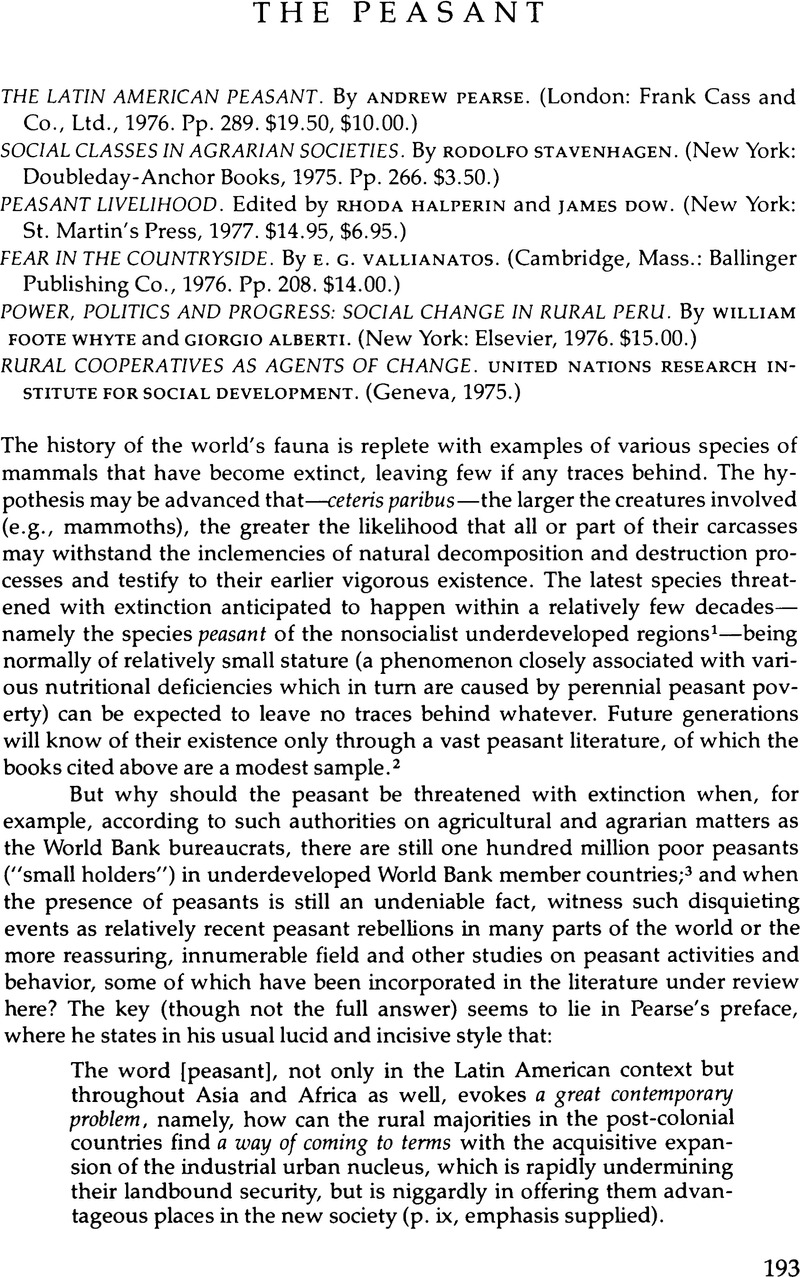Article contents
The Peasant
Review products
Published online by Cambridge University Press: 24 October 2022
Abstract

- Type
- Books in Review
- Information
- Copyright
- Copyright © 1978 by the University of Texas Press
References
Notes
1. I exclude socialist agricultures because the literature under review focuses on the capitalist countries, with the exception of Pearse (pp. 243–50).
2. My argument that peasants are about to become extinct may sound exaggerated to some readers. For a similar view, see Roger Bartra, “Y si los campesinos se extinguen?,” Historia y sociedad (México, D.F.), no. 8 (1976). In German, published in Lateinamerika, Analysen und Berichte 1 (Berlin: Olle und Wolter, 1977).
3. See, for example, Robert McNamara's “Address to the World Bank's Board of Governors,” Nairobi, 1973.
4. See, for example, Ray A. Goldberg, Agribusiness Management for Developing Countries-Latin America (Cambridge, Mass.: Ballinger Publishers, 1974), pp. 44, 110, where this guru of agribusiness lumps domestic (U.S.) and foreign growers together under the heading “U.S. Fruit and Vegetable Market System, 1971.”
5. Hence it is no coincidence that, for all practical purposes, agrarian reforms are now a dead issue in underdeveloped countries.
6. I have discussed these issues in “McNamara's Little Green Revolution,” Comercio exterior (English edition), August 1976 and in “Agribusiness in Underdeveloped Agricultures: Harvard Business School Myths and Reality,” Economic and Political Weekly (Bombay), 17 July 1976. In Spanish in Revista mexicana de sociológia (Spring 1977).
7. Renate Rott, “Strukturelle Heterogenität und Modernisierung,” Berlin, Freie Universität, 1977.
8. “Structural Changes in Third World Agriculture as a Result of Neo-Capitalist Developments,” The Developing Economies (Tokyo), September 1974, pp. 207, 209.
9. Two chapters of Pearse's book were published on previous occasions: chapter 2 (“The Context of Peasant Action”) in a slightly abbreviated form in my La lucha de clases en el campo (México, D.F.: Fondo de Cultura Economica, 1973), and chapter 4 (“Peasants and Revolution in Bolivia”) in Economy and Society 1, no. 4.
10. Pearse's approach in this respect is similar to Eric Wolf's excellent “Fases de la protesta rural en América Latina,” in my La lucha de clases, chapter 13, wherein the author explains changes in the forms of rural protests in terms of changes in the aggregate socioeconomic structure.
11. Rhoda Halperin does define peasants (pp. 11ff) in “terms of three dimensions of the substantive economy—the physical, the cultural and the social, … used to facilitate the understanding of process of livelihood.” Pearse is considerably more to the point. He defines the peasant as “the agricultural producer and cottage draftsman of preindustrial and partially industrialised societies who produces for the provisioning of his own household, and for market exchange, and lives in landgroups … with others of his kind with whom he shares certain facilities and services and day-to-day social interaction” (p. 1)—a definition which is simple and “operational” and satisfying. He emphasizes later (p. 73) in a footnote that his “use of the word peasant is less categoric [than Caio Prado Jr.'s, the great Brazilian social scientist] and therefore can apply to all who labour with the exception of those who have no access to land on their own account, and who live from wages in towns and cities.”
12. My own leaning would be in the opposite direction. Since irrigation systems function (and function best) when the various users of water plan and manage it in a coordinated and cooperative manner, they could be—and often are—the basis for a democratically organized community, dependening on the overall socioeconomic and political structure of the state.
13. Solon Barraclough has repeatedly demonstrated the irrelevance of these concepts.
14. The author's greatest merit lies in drawing attention to a widespread misconception that peasants are lazy, drunken, inefficient, irresponsible and so forth, and hence not worthy of credit and other assistance. The chapter does not reply effectively to that accusation that, after all, is the response of the landed elite to the just reclamation of an oppressed peasantry, for the purpose of intensifying the terror.
15. In this context, I should like to draw attention to a new booklet that deals with some of the problems of the modern peasant world: Theodor Bergmann, Structural Changes and Political Activities of the Peasantry (Occasional Paper No. 7, SSIP Verlag, Saarbrücken, 1976 [Germany]).
- 1
- Cited by




